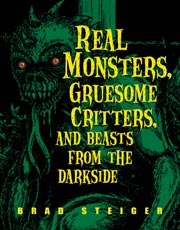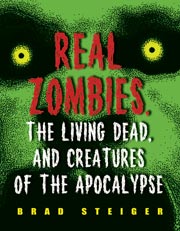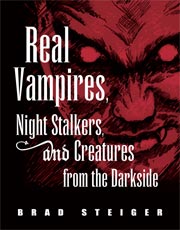The Rugarou, werebeast of the swamp Indians
Perhaps the man with the incredible rage who attacked a stranger and tore out a chunk of his flesh was possessed by the Rugarou, a type of Wendigo or werewolf known to the tribal people who inhabit the swamps of Louisiana. In this account folklorist and occultist Alyne A. Pustanio, whose roots go deep into the local culture, shares the legend of this frightening creature.
According to Alyne A. Pustanio:
Once there was a swamp trapper who used to parade about in the skins of the animals he had caught, terrifying neighbors and friends by pretending to be the Loup Garou (werewolf). When the disrespectful trapper fell under the eye of a Louisiana Indian shaman it is said that the man danced a different dance thereafter--as a real Loup Garou under the yellow swampland moon.
The heritage of Louisiana's Native American peoples is rich with tall tales and legends and among these the tale of the werewolf looms large. The Indians know the werewolf as the shape-shifting "Rugarou," a variation of the Cajun French "Loup Garou." But the name matters little--Rugarou, Loup Garou, shape-shifter or skin-walker--these deadly, half-human beasts have been part of the legacy of terror that has haunted the Louisiana swamps for generations. One of the most chilling tales told among the Indian tribes of South Louisiana concerns a warrior tribe of cannibals and how they came to be known--and feared--as Wolf Walking man-eaters. This is that tale.
Where modern-day parish boundaries now exist there were once the mutable limits of the tribal nations of the Opelousas and the Chitimacha; and there exists in the oral tradition of all these tribes a shared memory of vicious and powerful warriors who once held sway over large areas of native lands, using their powers to instill fear among their own people and to manipulate or control their rivals.
This was the Attakapas tribe, and they were the source of much fear and loathing among the swamp Indians who shunned them for their reputation as a nation that cannibalized its enemies. But many Louisiana Indian legends hint at something even more sinister at work among the Attakapas. Many believe this dark secret to be evidence of a skin-walking tradition that, if true, would mark the Attakapas as something unique in the annals of lycanthropy: an entire tribe of werewolves.
Only a very few of those who have studied the history of Native Americans in this area of Louisiana are not familiar with the story of these cannibalistic warmongers, whose name, "Attakapa" in Choctaw means "Man-Eater." The Chitimacha and Opelousas tribes were the traditional enemies of the Attakapas, and it was an unstated fact that any conflict with them (the Attakapas) simply had to be won because the Attakapas were long in the habit of eating their captives.
In one such battle in the 1700s the three tribes went to war in a low country six miles outside of what is today St. Martinville. The Chitimacha and Opelousas won the day and decimated the Attakapas tribe. Only a half dozen or so were said to have survived the conflict, fleeing to refuge in the area around what is now Indian Bend. Fearing retribution from the victorious tribes, the local people--mostly Cajuns and Spaniards--the Attakapas ran away into the unforgiving swamps.
These swamplands were described by early explorers as "embracing such half-solid, half-fluid areas of no agricultural value, but supporting a forest growth so dense with cypress, tupelo, gum, water oaks, ferns, palmettos, and a network of ancient vines, that the appearance is similar to that of the Mayan jungles." The swamps were then (and for the most part still are) only sparsely inhabited by hunters, trappers, and fishermen who lived in palmetto tents and small frame houses or houseboats along the interior bayous.
The renegade Attakapas were unwelcome interlopers in this strange country. None less than Cabeza de Vaca, who encountered them on his travels, reported that after the great battle the few surviving Attakapas lived for a while in this environment, subsisting on roots and fish. Some bravely appeared as beggars in the settlements along the edge of the swamplands. But soon they were discovered by members of their fierce rival tribes who chased them back to the swamps--if they could not kill them. In the harsh winter following the great battle, the remnant Attakapas were forced to find a way to survive in the unforgiving environment they now called home.
Some traditions, including Spanish accounts of that time, suggest that the Attakapas, exhausted as subjects of fear and hatred, turned to their shamans for answers. It is said that these elders, once servants of the Great Spirit, now turned aside from the enlightened path and, in desperate search of help and sustenance for their people, began to feel out the heart of darkness for answers. According to all accounts, something responded.
It is said that dark spirits came down and entered into the starving Attakapas. In desperation they had obtained a unique gift: the power of shape-shifting at will. Once notorious as cannibals in conquest, the Attakapas, so other Indian wise men taught, gave over entirely to their animal nature and had somehow transcended the deprived state of their humanity, crossing over into the realm of the animals. Not only this, their numbers were once again growing. They were now predatory hunters, and humans were their prey.
Not surprisingly, winter was the time when the shape-shifting Attakapas were most feared. In the summer, it was said, they seemed to live as other human beings, content with small harvests and the food sources provided to them by their environment. Only the most brutal-natured of them remained in their animal forms all the time. But when the bare winter months came on, bringing in the damp Louisiana chill, sending fish to the bayou bottoms and making other animals scarce, it was believed that all Attakapas--men, women, and even children--lived constantly in their animal forms and were most to be feared.
As the short winter days gave on to long, moonlit nights, so the legends say, the Attakapas "Rugarou"--driven to frenzy with memories of starvation--would leave the swamp and traverse the low country nearby in search of humans to devour. More frightening still was the knowledge--especially among the Chitimacha and the Opelousas--that the beasts were not driven by fear alone; revenge, too, was ever-present in their hearts.
Today the Chitimacha are the only tribe left who prosper in the area, though the Opelousas endure in lesser numbers. This, however, has done nothing to lull these ancient peoples into complacency, especially where the Rugarou is concerned. Fear still lingers among them, particularly when a cold, hard winter sets in and the dampness chills the bones. Then their thoughts turn to their long enemy, the Man-Eaters, the Attakapas, and they wonder if--or when--the Wolf Walkers will strike again.
Recently, the discovery of the grisly remains of mutilated farm animals and sightings of ghostly figures lurching close to the ground near darkened roadsides have been reported from the Chitamacha reservation near Charenton, Louisiana. Many believe that the Rugarou are once again active. Tribal elders have blamed the strange activity on the series of devastating storms--first Hurricanes Katrina and Rita, and more recently Hurricane Gustav--that have struck the area in the last few years. They say the fragile eco-system of the nearby swamplands was impacted and may have affected the resources on which the Rugarou have long been dependent. Many fear these natural disasters may have turned the Wolf Walkers back to their predatory ways.
Once again the Native Americans who live on the edge of the noisome Louisiana swamps are speaking in nervous whispers and the tale of the killer Attakapas is being retold to a new generation. These tribes know, and must let others know, that as the fortune of the land goes, so, goes the vengeance of the dreaded Rugarou.
From Real Zombies, Living Dead, and Creatures of the Apocalypse by Brad Steiger, (c) 2010 Brad Steiger
The macabre history of the undead and chilling stories of real life zombie encounters.










